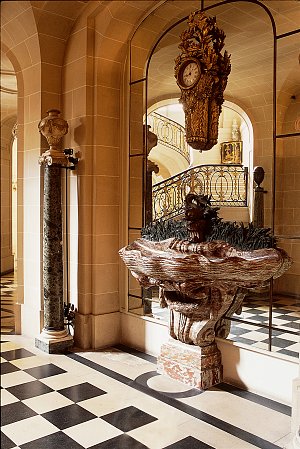Guests arriving at Moïse de Camondo’s home were welcomed here, in the Hall. The Hall and Gallery are on the same level as the main courtyard; the other parts of the Lower Ground Floor are half underground on the garden side, and contain the service areas. The walls of the Hall and stairwell are made of stone from the Ile-de-France area rather than stucco, as Moïse de Camondo asked his architect, René Sergent, not to use replacement materials.

La galerie du rez-de-chaussée bas
©
MAD Si vous souhaitez utiliser ce visuel, veuillez contacter la photothèque
One of the first things you see when you enter the Hall is a flat mahogany desk stamped by Jean-Henri Riesener and a mahogany and gilt bronze “regulator” (longcase clock). Behind the stairwell is a “rouge royal” marble shell-shaped fountain, topped by a gilt lead dolphin. The large gate opposite the fountain opened onto a covered passageway that sheltered visitors from rain as they alighted from their cars.
At the foot of the Great Staircase leading to the Upper Ground Floor stands a white marble statue of Venus and Cupid. Moïse de Camondo could not find an antique wrought iron banister to fit the curve of the staircase, so he had a copy made of the one in the Hôtel Dassier, on rue des Couteliers in Toulouse – a masterpiece made around 1780 by the metalworker Joseph Bosc.
On the landings are two Japanese lacquer corner cupboards, attributed to the cabinetmaker Bernard van Risen Burgh (B.V.R.B.); the Chancellerie tapestry on the wall was woven at the Gobelins factory around 1680 for the Chancelier d’Argenson, whose coat of arms it bears.